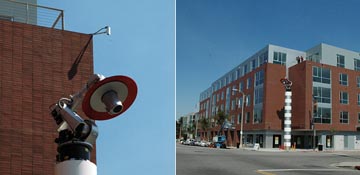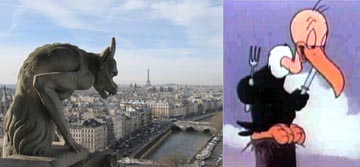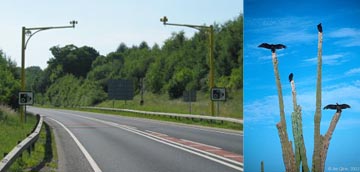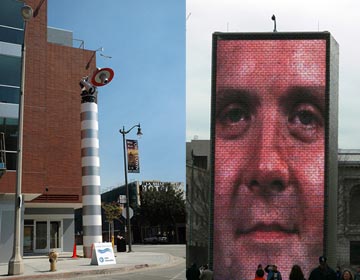Artist Christian Moeller is completing “Mojo”, an interactive public artwork in San Pedro, California, 20 miles south of downtown Los Angeles. The developers of Centre Street Lofts funded the vulture – and the creepiest public art in 2007.
Clearly, Moeller steps on every fear of surveillance: 1. a generally unsafe street at night, 2. potential attack by a thug or stalker in any neighborhood, 3. innocent movements recorded by unknown and untrusted authority and 4. police (or prison guards) spotting YOU in a searchlight.

Photos by Marshal Astor, Life on the Edges
Based on the writing of Hugh Hart, the robot with a spot light head can track a pedestrian on the sidewalk. A computer receives information on human movements though two cameras and direct the robot to hit and then follow the pedestrian with the light. We are naively accustomed to the garage door floodlight activated by motion, but we are not accustomed to being followed.
Perhaps it is fun as it is Los Angeles. Everyone wants to be in the spotlight. Perhaps karaoke street parties should be held. The more energetic will attempt to out run or zigzag the robot. Others with attempt to confuse the robot the multiple pedestrians moving in different directions.
I admire Moeller for discovering a visual form to test our apprehensions about surveillance. Normally, artwork about surveillance is virtual or documentary. Moeller’s sculptural form and interaction have the potential to experience fear.
My first instinct regarding the robot on a pole was a vulture. Not a real vulture, but a Looney Tunes memory from my youth. (An Internet search only produced Bob Clampett’s “Beaky Buzzards” of 1942-45. Perhaps?). The long necked buzzard surveyed the California desert for a meal.

Notre Dame and Beaky Buzzard
In our brains, we make this link of drawn/graphic annimation with robots. In LA Curbed.com, other commentors invoked annimated images of the desk lamp at the beginning of Pixar movies or the some device from “Honey I Shrunk the Kids”. Moellers’s black and white striping of the pole perch of the vulture reinforcing the graphic connection.
The sculpture’s location at the corner of the building seeks memories of the gargolye- another fantasy mixing danger, protection and survelience from the space above. Via gargolye, cartoon or actual vulture atop cacti or telephone poles, Moeller’s visual form brings the sensation of surveillance into the street.

UK Yellow Vultures and CA Turkey Buzzards
Of course survelience is excellerating everywhere. In the UK, new camera above the highway to track speeders have earned the name, “Yellow Vultures”. According to the Chicago Tribune, Mayor Daly wants more than 100 new police cameras for high crime streets to join the numerous cameras through out the Chicago housing projects.
In 2006, US Homeland Security gave Chicago $52 million and small part of that money installed surveilence cameras appeared atop Jaume Plensa’s Crown Fountain in Chicago. The Chicago Tribune quoted James Yood, professor of art history at the School of the Art Institute of Chicago. That is one of those `What were they thinking?’ kind of moments, ” to place the camera on top of the public art work. In the two massive stellas of glass blocks, photographs of Chicago citizens are illuminated and even spray a cool shower of water from their mouths (Back to gargoyles again) The camera “changed the whole idea of the sculpture, which is that these are our brethren,” Yood said. “Now instead of looking at us, they’re surveilling us, which I think is not exactly the artist’s intention.”

Moeller by Marshal Astor. Plensa photo by Looper
In Plensa’s photographs, the citizens stare into the space above the visitor’s head. Looking at you is not part of the work. The work wants to be looked at like a traditional painting, not engaged like the fountain suggests. Plensa missed the opportunity to finds a great new work of art. Perhaps the Chicago police were attempting to remind Plensa on his failure that Moeller is attempting to solve.
We are at the beginning of all of this new public art and public space making with electronics and therefore we can have honest debates. No one knows how the art in response to reality will turnout. No one knows where reality is headed. No one knows if the medium can remain the message when the medium and message go underground.
Public Art, Public Space

brilliant.